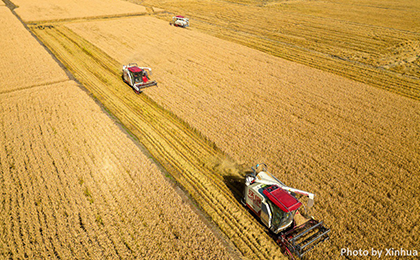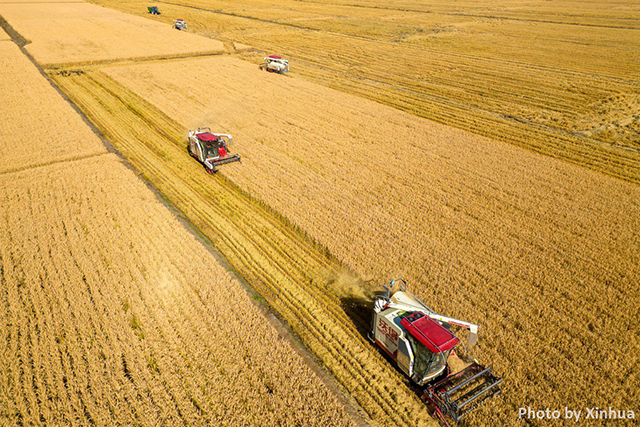



▲An aerial drone photo shows agricultural machines working in fields at a farm of Beidahuang Group in Northeast China's Heilongjiang province. [Xinhua]
3. Accelerating Modern Agricultural Development and Strengthening the Foundation of Food Security on All Fronts.
3.1 Improving the supply security of grain and important agricultural products.
Ensuring national food security is the primary task of modern agricultural development, proposing the goal of ensuring that grain planting areas remain stable at about 1.75 billion mu (about 117 million hectares), with cereal areas around 1.45 billion mu. Vigorously implement the grain yield per mu improvement project to promote a steady increase in grain production capacity to reach about 1.4 trillion jin (700 billion tonnes). Deeply implement the national soybean and oil crop production capacity enhancement project, combining agriculture, forestry, animal husbandry, and fishery to build a diversified food supply system. Implement cotton target price policies and strengthen the construction of sugar crops and natural rubber bases. Improve market monitoring and early warning systems, coordinate market-based grain procurement and policy-based reserves, improve reserve systems and institutional construction, optimize market regulation mechanisms for pigs, cotton, and sugar, and strengthen emergency supply capacity.
3.2 Strengthening agricultural infrastructure construction.
Step up financial support to cultivate high-standard farmland, gradually convert eligible permanent farmland into high-standard farmland, improve cultivation standards and quality, perfect cultivation, acceptance, and maintenance mechanisms, and support new agricultural business entities and rural collective economic organizations to participate in cultivation and maintenance. Deeply implement the national black soil protection project and accelerate irrigation district construction and renovation. Develop modern facility agriculture. Strengthen agricultural disaster prevention, mitigation, and relief capabilities, enhance agricultural meteorological disaster monitoring, early warning, and prevention, implement plant and animal protection projects, and improve crop pest control and animal disease prevention systems.
3.3 Strengthening agricultural science, technology, and equipment support.
Optimize the scientific innovation system, provide stable support for basic research and public welfare research institutions, and establish a classified evaluation system for scientific and technological innovation. Construct major scientific and technological infrastructure, increase efforts in key core technology breakthroughs, and improve the agricultural technology extension service system. Accelerate seed industry revitalization, build facilities and platforms for germplasm resource preservation and identification; accelerate core seed source technology breakthroughs, and cultivate large-scale seed enterprises. Accelerate the research and application of large-scale high-end intelligent agricultural machinery, small machinery suitable for hilly areas, and key core components; vigorously develop smart agriculture; improve subsidy policies of agricultural machinery purchase and usage.
3.4 Increasing support for grain production.
Improve income guarantee mechanisms for grain farmers as well as the grain production subsidies, implement the minimum purchase price policies, improve the agricultural materials supply guarantee and price stabilization mechanisms, implement full-cost and planting income insurance policies for grain crops, encourage qualified provinces to implement differentiated premium subsidy policies and increase support for major grain-producing counties. Strengthen support for main grain-producing areas, reasonably arrange incentive fund scales for major grain-producing counties, and coordinate the establishment of inter-provincial horizontal interest compensation
4. Promoting High-Quality Development of Rural Industries and Increasing the Growth of Farmers' Income.
4.1 Building a modern rural industrial system.
Cultivate modern rural industries, develop rural farming and breeding, processing and distribution, leisure tourism, and rural services. Implement agricultural brand cultivation programs focusing on major agricultural production areas and regions with advantages in specialty agricultural products. Optimize industrial chain organization, cultivate leading agricultural industrialization enterprises, and support collaborative industrial and supply chain development among enterprises. Strengthen industrial development carriers, support county-level rural industrial integration projects, and develop advantageous specialty industry clusters.
4.2 Deepening the integrated development of primary, secondary, and tertiary industries in rural areas.
Implement agricultural product processing industry enhancement actions while supporting the construction of processing industrial parks in major production areas. Improve the backbone distribution network, upgrade wholesale markets, plan and build suburban warehouse bases, and implement high-quality rural e-commerce development projects. Systematically develop new business forms such as agricultural experience, and explore integrated development of modern agriculture, leisure tourism, and garden communities.
4.3 Strengthening initiatives to increase farmers' income.
Implement employment stability policies and rights protection mechanisms for migrant workers, strengthen skills training and employment services, and support entrepreneurship for those returning to rural areas. Improve industrial chain benefit-linking mechanisms, develop agricultural industrialization consortiums, guide enterprises to strengthen benefit connections with individual farmers, and promote the distribution of value-added benefits toward farmers. Cultivate and expand new types of agricultural business entities, and link relevant support policies with driving increases in farmers' income.
4.4 Promoting rural consumption comprehensively.
Advance county-level commercial system construction, improve e-commerce and logistics service systems, build county-level collective procurement and distribution centers, promote the integrated development of passenger, cargo, and postal services, and accelerate consumption expansion. Support the rural promotion of new energy vehicles and green smart home appliances, implement the consumer goods trade-in program, and encourage information consumption. Develop rural life services and improve the supporting facilities for consumption.
Source:<https://www.gov.cn/zhengce/202501/content_7000499.htm>
Editor & Translator: GUO Xinxin